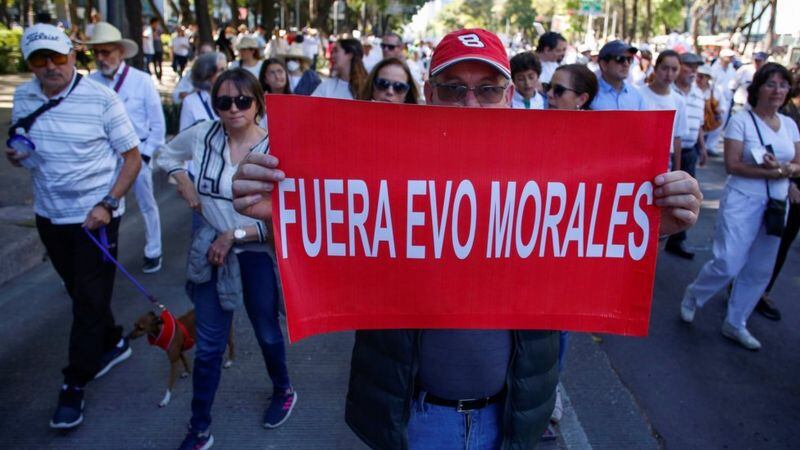Since November 12, 2019, Evo Molars has not missed an opportunity to thank Andres Manuel Lopez Obrador (AMLO) for having “saved his life”. The first time she did it was that same day, minutes after landing in Mexico City aboard a military plane. One of his last times was three months ago, when he boasted how “his soul brother” invited him to the celebrations for the Mexican national holidays in that country.
LOOK: Which politicians did AMLO shelter since he became president, what were they accused of and how did they end up?
Three years ago, the former president of Bolivia had just arrived as a political refugee after being forced to resign his position. The crisis derived from questionable presidential elections –crowned with an OAS report denouncing irregularities in the elections– mobilized the armed forces against Morales, who, denouncing a coup, fled the country.
Their arrival in Mexico required a complex rescue operation. The Mexican Air Force plane that was supposed to pick up Morales received several refusals to land, being forced to return to land and change its route –for which permissions from Peru, Bolivia, Paraguay and Brazil were required– until it finally arrived at Mexico.
In the Aztec country his reception could not have been better. The foreign minister, Marcelo Ebrard, gave him a hug as soon as he got off the plane. The Mexican government welcomed the theory of the coup d’état in Bolivia without qualms, and AMLO himself said he was proud to give Morales protection, while journalists and even sympathizers completed the reception. But it soon became clear that he was going to be a controversial refugee.
“With just 24 hours in the country as a political refugee, Evo Morales was treated as a state visit, with security conditions that not even President Andrés Manuel López Obrador has had, such as the accompaniment of former security agents who at the time protected Enrique Peña Nieto when he was president”, said then the newspaper “El Universal”.
Thank you very much brother of the soul, @lopezobrador_ for the invitation to celebrate the national holidays of Mexico in that country that saved our lives and served as a refuge from the persecution of coup plotters in 2019. The integration of Latin America is sustained by the solidarity of its peoples pic.twitter.com/o89sEaru2n
— Evo Morales Ayma (@evoespueblo) September 2, 2022
In the month that he spent in asylum in Mexico – he would later be granted the same grace in Argentina – Morales was far from maintaining a discreet profile. In addition to traveling in four armored trucks and being escorted by 14 plainclothes guards, he met his supporters, gave press conferences in hotels, met with politicians from the ruling party and, via Twitter, had almost daily confrontations with the government of Jeanine Áñez, who assumed power in Bolivia after her resignation.
The de facto government of Añez does not respect the dead in their coffins, nor does it forgive their relatives, women and children who marched peacefully for respect for life and democracy. We condemn the violence that is perpetrated against our brothers and sisters #StopTheMasacre pic.twitter.com/61fjwRfWze
— Evo Morales Ayma (@evoespueblo) November 21, 2019
AMLO’s seal
It was not a surprise that the asylum sparked controversy and harsh criticism of AMLO. From marches of rejection by Mexicans and Bolivians to questions from politicians and representatives of civil society to the “golden exile” of Morales. Surveys published in those weeks stated that between 55% and 68% of citizens rejected his presence in the country, recalls the BBC.
Although the asylum seemed to be in line with the historical Mexican tradition of providing political protection, Raúl Trejo, a researcher at the Social Research Institute of the UNAM and a columnist in the newspaper “Crónica”, affirms that AMLO located the asylum for Morales in that context for your own benefit.

“In the last 50 years, Mexico has played a prominent role supporting very diverse characters, but always within diplomatic rules. And this has been broken by López Obrador, who seems to act more on whims or personal impulses than taking international rules into account.”, he tells El Comercio.
In the weeks after the asylum, public opinion in Mexico was divided between AMLO’s supporters who blindly supported him, and his opponents and other civil society actors, who claimed that Mexican foreign policy was being distorted, something that, these days he has returned to the debate with the offer of asylum to former coup president Pedro Castillo.
For Nayar López, a professor at UNAM’s Faculty of Political Sciences, those who defend AMLO’s approach highlight his commitment to rescuing the Estrada doctrine, which characterized Mexican foreign policy for a good part of the 20th century, and which, according to the Government, It is key to reinforce the image of Mexico abroad.
“As any government has its political tendency, I would place the AMLO government as one of the center-left, and in this sense it must be understood that it has not yet recognized the president that Congress has appointed in Peru”, says the expert.
For his part, Trejo considers that the solitary support for former President Castillo confirms that for the Mexican president “their interests and sympathies are above legality”.
Source: Elcomercio
I am Jack Morton and I work in 24 News Recorder. I mostly cover world news and I have also authored 24 news recorder. I find this work highly interesting and it allows me to keep up with current events happening around the world.

:quality(75)/cloudfront-us-east-1.images.arcpublishing.com/elcomercio/2YT5ICM3FBAJBBISGXK3N2DLDQ.jpg)

:quality(75)/cloudfront-us-east-1.images.arcpublishing.com/elcomercio/M3B4ABO36ZCYRCHQRU6CFMWRHM.jpg)
:quality(75)/cloudfront-us-east-1.images.arcpublishing.com/elcomercio/5QHXBF3WQFDJRAZZVWS3C6DV4M.jpg)
:quality(75)/cloudfront-us-east-1.images.arcpublishing.com/elcomercio/BUO6EJ5KRZHLFCS3FWMMF5HBPQ.jpg)
:quality(75)/cloudfront-us-east-1.images.arcpublishing.com/elcomercio/4XELV2MPRJBEFAQHHY3C43N2BY.jpg)
